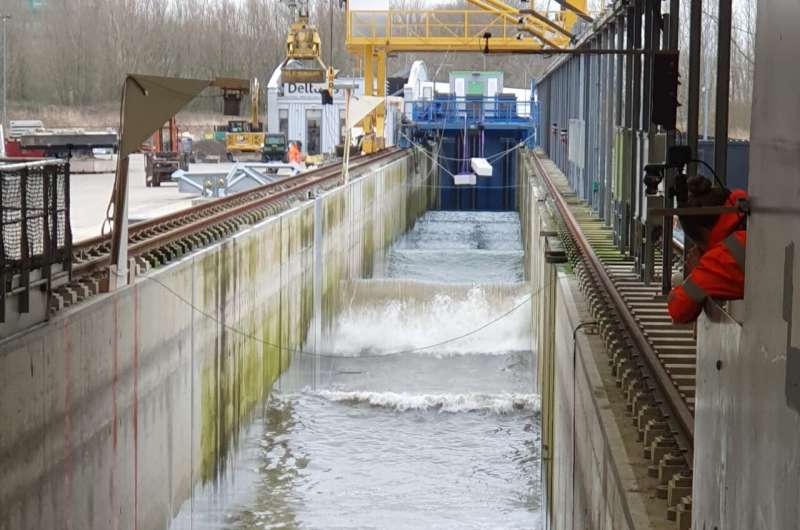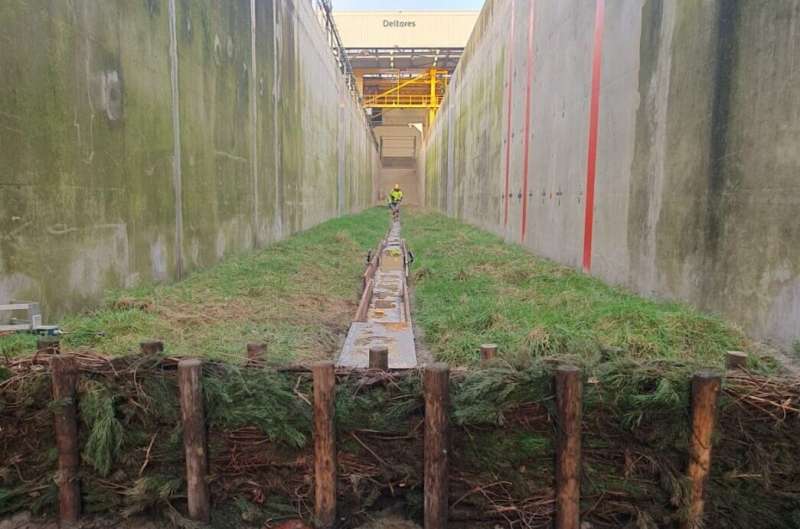Salt marshes put to the test in wave flume
Can salt marshes serve as a natural solution for flood protection? Researchers of the project “Living Dikes” transported 62 big blocks of salt marshes, containing soil and vegetation, from the coast of Friesland to the Delta Flume at Deltares. After four weeks of exposure to extreme waves, almost the entire salt marsh is still standing there.
In order to keep the Netherlands well protected, our dykes need to withstand waves of up to 4 meters. This might mean that kilometers of dykes need to be raised. What has not been considered, is the effect of salt marshes. The concept is that vegetation aids in mitigating the impact of waves on man-made dykes by diminishing wave height and crucially, by stabilizing the soil in front of the dyke. However, due to limited data availability, the extent to which we can depend on salt marshes as integral components of flood protection systems remains uncertain.
In the Delta Flume, waves up to 4 meters run over 70 meters of salt marsh. TU Delft Assistant Professor Alessandro Antonini designed the experiments during the Living Dikes project to see whether the salt marsh can withstand extreme storms and if, and how much, it can reduce the hydrodynamic load of the dyke.
Salt marsh resisted extreme storms
After four weeks of testing and many days of artificial “storms,” the experiment has come to an end. Antonini is amazed to see that the soil is still there. “The level of erosion was minor for large part of the tests. We expected the soil and vegetation to be eroded and damaged much more and faster.” These are signs that perhaps the salt marshes can resist during the most extreme storms in The Netherlands.

Laser scanners, cameras, wave gauges, and pressure transducers gathered extensive data. With this wealth of information, researchers can now assess the dampening effect on waves. It could potentially establish salt marshes as dependable elements of coastal protection, potentially saving significant resources in both financial expenditure and urban space that would otherwise be allocated to fortifying our flood defenses.
In the previous phase, they tested on a smaller scale at the TU Delft Waterlab. Dimitris Dermentzoglou and Jos Muller prepared 50,000 rubber grass blades and tested it in the flume.
Citation:
Salt marshes put to the test in wave flume (2024, March 21)
retrieved 21 March 2024
from https://phys.org/news/2024-03-salt-marshes-flume.html
This document is subject to copyright. Apart from any fair dealing for the purpose of private study or research, no
part may be reproduced without the written permission. The content is provided for information purposes only.

Can salt marshes serve as a natural solution for flood protection? Researchers of the project “Living Dikes” transported 62 big blocks of salt marshes, containing soil and vegetation, from the coast of Friesland to the Delta Flume at Deltares. After four weeks of exposure to extreme waves, almost the entire salt marsh is still standing there.
In order to keep the Netherlands well protected, our dykes need to withstand waves of up to 4 meters. This might mean that kilometers of dykes need to be raised. What has not been considered, is the effect of salt marshes. The concept is that vegetation aids in mitigating the impact of waves on man-made dykes by diminishing wave height and crucially, by stabilizing the soil in front of the dyke. However, due to limited data availability, the extent to which we can depend on salt marshes as integral components of flood protection systems remains uncertain.
In the Delta Flume, waves up to 4 meters run over 70 meters of salt marsh. TU Delft Assistant Professor Alessandro Antonini designed the experiments during the Living Dikes project to see whether the salt marsh can withstand extreme storms and if, and how much, it can reduce the hydrodynamic load of the dyke.
Salt marsh resisted extreme storms
After four weeks of testing and many days of artificial “storms,” the experiment has come to an end. Antonini is amazed to see that the soil is still there. “The level of erosion was minor for large part of the tests. We expected the soil and vegetation to be eroded and damaged much more and faster.” These are signs that perhaps the salt marshes can resist during the most extreme storms in The Netherlands.

Laser scanners, cameras, wave gauges, and pressure transducers gathered extensive data. With this wealth of information, researchers can now assess the dampening effect on waves. It could potentially establish salt marshes as dependable elements of coastal protection, potentially saving significant resources in both financial expenditure and urban space that would otherwise be allocated to fortifying our flood defenses.
In the previous phase, they tested on a smaller scale at the TU Delft Waterlab. Dimitris Dermentzoglou and Jos Muller prepared 50,000 rubber grass blades and tested it in the flume.
Citation:
Salt marshes put to the test in wave flume (2024, March 21)
retrieved 21 March 2024
from https://phys.org/news/2024-03-salt-marshes-flume.html
This document is subject to copyright. Apart from any fair dealing for the purpose of private study or research, no
part may be reproduced without the written permission. The content is provided for information purposes only.
